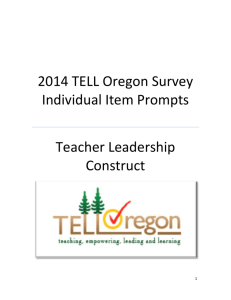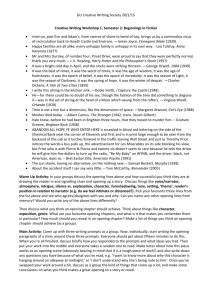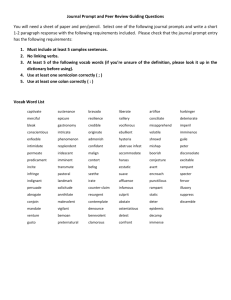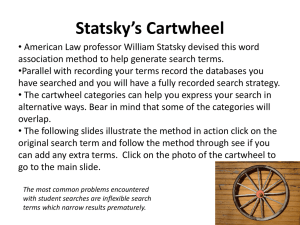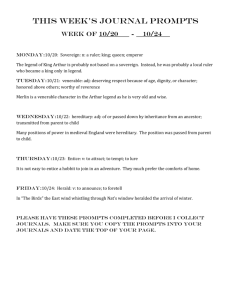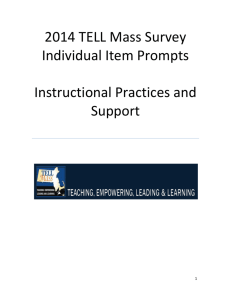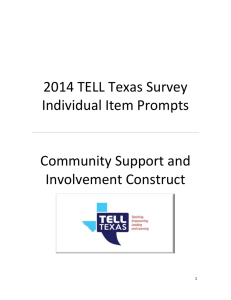Facilities and Resources
advertisement
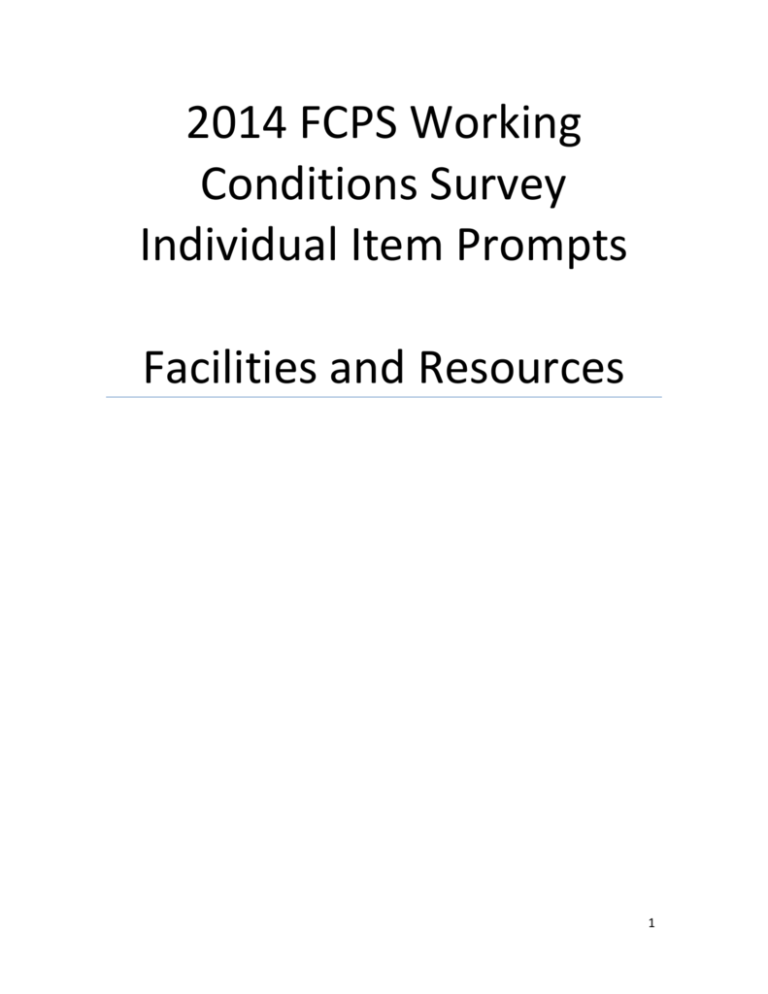
2014 FCPS Working Conditions Survey Individual Item Prompts Facilities and Resources 1 Facilities and Resources Discussion Guide For 3.1A-E When examining specific areas of a school’s facilities and resources, challenges may not be in the lack of resources present. They may, instead, lie in the allocation of resources, management and maintenance of existing resources, or perhaps the accessibility to resources. As you reflect on the specific conditions within your school, consider the policies and procedures in place to allocate and maintain your resources. Does the faculty know how to access the materials? Have teachers been trained on the materials and resources? If training has been provided, has there been follow up from the administration on effectively utilizing the resources available? Is there an equitable process for gaining access to facilities and resources? Perhaps a discussion of the distribution of resources and funds from the district level down to the individual schools could help teachers to frame the quantity and quality of the materials they have access to in the school. Knowing who makes choices and how those decisions are made could improve teacher perception of these areas of the survey. Are there ways teachers can be included in the process? Table Group Activity Where possible, include an administrator in each group to have both perspectives represented. Assign a recorder. The following pages provide question prompts on the survey item discussed above. Read and discuss the prompts as a group. o Try and capture both administrator and teacher perspective on the prompts Use the Item Analysis tools to record important points brought up in your discussion. 2 3.1A- E: Reflections In your discussion of specific facilities, personnel and resource issues, how do you and your staff define the term "sufficient" in this item’s question? •Is that definition different between the administration and teachers? •How do the resources at your school compare to similar schools across the district? What policies are currently in place to utilize available materials or personnel? •Are there steps within your control to improve the availability and accessibility of these materials? •Are all teachers adequately trained on the effective use, policies, and procedures of the available resources? What about new teachers? Is access to resources and personnel equitable across grade levels, teams, and subject areas? Across veteran and new teachers? 3 3.1A-E: Reflections continued... Is it a question of the resources or personnel functioning properly when teachers need them? •How are resources maintained throughout the course of the year? •If something breaks down, what is the procedure in place to get it fixed? •Is there a way determine when resources are misused. •What is the staff’s commitment to maintaining the existing resources they currently have access to? •Do new teachers know the policies and procedures that are in place to use resources? How are decisions made about purchasing new materials and resources or about allocating personnel? •Do teachers have any say in the process? •How are funds appropriated? •How are people and positions allocated? Is this a local, district or state decision? •How do the ideas of teacher need and efficacy play into the decision making process? 4 3.1A-E: Reflections continued... What does adequate work space look like? •How do you define adequate? •How do you come to consensus on adequate space? •Do some educators need more or less space than others? •Is the space public or private? For what type of work do you need the space? •Is this space for teaching students or for supporting teachers? •Will we need room for collaborative meetings? What constitues support of teaching and learning? •How can a physical environment affect learning? •Does the lay out of the classrooms and building as a whole enhance or deter our instructional focus? •Do our classrooms promote collaboration or isolation? 5 3.1F: Teachers and staff work in a school environment that is clean and well-maintained. When reflecting on this survey item, consider how the staff defines a school that is clean and well maintained. What are staff expectations of their classrooms? What are the expectations of the halls, restrooms, and public areas? What are the expectations of the school grounds? What is the faculty’s position on the role that students play in the maintenance of their school and community areas? Does the staff know who to contact if they have a particular need in this area? Is there a specific procedure to get maintenance issues addressed? If the issues are linked more to community space, are teachers working together throughout the day to consistently monitor the areas? Table Group Activity Where possible, include an administrator in each group to have both perspectives represented. Assign a recorder. The following pages provide question prompts on the survey item discussed above. Read and discuss the prompts as a group. o Try and capture both administrator and teacher perspective on the prompts Use the Item Analysis tools to record important points brought up in your discussion. 6 3.1F: Reflections Define what you consider a clean and well maintained to be. •What does it look like? •What do the classrooms look like? •What do the public areas look like? •What do the outdoor areas look like? What cleaning and maintenance are currently in place? •How often is professional cleaning and maintenance taking place in your classroom and what does it include? •How often is professional cleaning and maintenance taking place in your public areas and what does it include? •How often is professional cleaning and maintenance taking place in your outdoor areas and what does it include? •Do trailers and supporting facilities get the same quality of attention as the main building? If you have a specific need... •Does the staff know who to speak to in the administration to address specific concerns? •How fast is the turnaround on specific concerns? •Can the system be more efficient? What can I do to contribute to the cleanliness and maintenance of our school? •What policies do I have in place with my children to promote cleanliness? •Do I enforce school policies in public and community areas? •What sorts of relationships do I have with the professional maintenance staff at our school? •Do I acknowledge their hard work? How? 7 3.1G: Teachers have adequate space to work productively. Different teachers require different amounts of space to work productively. In addition to the number of students in a classroom, the subject being taught can have an impact on space requirements. A science classroom requires more space than other core classes because of the lab component. An instrumental music class requires specific room to accommodate instruments and stands. While some teachers have their own classrooms, others may not. The space needs for a floating teacher are entirely different from a stationary teacher. This question is not limited to reflections on the classroom setting. Do teachers have adequate space to meet collaboratively and work in teams, by grade level, or as a school? Are there spaces in the school reserved for work rooms, meetings with parents, professional support staff, and administrators? Does the faculty know the policies and procedures for using conference rooms or other community space? Are there sufficient areas for athletics activities and student gatherings (indoor and outdoor)? Table Group Activity Where possible, include an administrator in each group to have both perspectives represented. Assign a recorder. The following pages provide question prompts on the survey item discussed above. Read and discuss the prompts as a group. o Try and capture both administrator and teacher perspective on the prompts Use the Item Analysis tools to record important points brought up in your discussion. 8 3.1G: Reflections Is there space available for teachers to meet and work collaboratively? •Is it available when teachers have time to plan and collaborate? •Is it conducive to working individually or in a group? •Is it permanent or temporary space? What policies are in place for managing community spaces like conference rooms? •Do all of the faculty know about these policies? How do you know? •Are all the community spaces being used effectively? •Are the systems in place equitable across all staff? Is space around the school being utilized effectively throughout the entire school day? •Are there spaces that could be repurposed when they are not being used? Is classroom space sufficient to meet teacher and student needs? •How does class size impact the use of space throughout the school day? •What steps can be taken to address imbalances in class size? What are some challenges to addressing class size? Is there sufficient space, indoor or outdoor, for athletic events and communal gatherings? •Do you have alternatives to classroom settings for athletic, arts or community events? 9 3.1H: The physical environment of classrooms in this school supports teaching and learning. Placement of materials, chairs, proximity of students to the teacher and each other, lighting, temperature, and safety all can play a role in creating an environment that is conducive to student learning. As you reflect on the classroom environments of your school, consider whether or not the physical space provides a secure and pleasurable working environment. Do classrooms and hallways reflect the people who teach in them and the topics that are being taught? Is there space to display the work? Does the layout and organization of the rooms support the work that is intended to be carried out in them? Finally, can teachers organize classrooms to best meet the needs of their students? Table Group Activity Where possible, include an administrator in each group to have both perspectives represented. Assign a recorder. The following pages provide question prompts on the survey item discussed above. Read and discuss the prompts as a group. o Try and capture both administrator and teacher perspective on the prompts Use the Item Analysis tools to record important points brought up in your discussion. 10 3.1H: Reflections Do the classrooms in your school reflect the people that teach them and the topics being taught? •Do walls have student work on them? •Are there materials around the room that reflect the content being address in the curriculum? •What resources are present to help students with disabilities? •What resources are present to support English Language Learners? Does the layout and organization of the classrooms, the media center, etc. support student learning? •Do students have enough chairs and desks? •Are the chairs, desks, and learning areas organized in a way that promotes effective learning? Is the classroom safe? •Are fire exits and safety protocol posted? •Are there clear lanes through the classroom to exits? •Are hazardous materials properly stored? •Are sensitive documents and materials locked away? Are supportive classroom environments consistent across the school? •Is there equity of resources across all subjects, grades, etc.? What systems are in place to help beginning teachers with classroom design and organization? 11 3.1I: The reliability and speed of network connections in this school are sufficient to support instructional practices. Access to a reliable and efficient network is an essential component for working in today’s public schools. Teachers need network access for communication, lesson building, research, accountability, assessment and lesson delivery. Students need access to sufficient network systems to become fluent in skills that are increasingly essential in a 21st Century society. In reflecting on this teaching condition, consider whether all teachers and students across the school have sufficient, equitable and reliable access to the network systems. What systems are in place for addressing network problems as they occur? Are all educators aware of the resources they have access to and proper training to utilize those resources effectively? Table Group Activity Where possible, include an administrator in each group to have both perspectives represented. Assign a recorder. The following pages provide question prompts on the survey item discussed above. Read and discuss the prompts as a group. o Try and capture both administrator and teacher perspective on the prompts Use the Item Analysis tools to record important points brought up in your discussion. 12 3.1I: Reflections Is the network connection at your school reliable? •Does the system consistently meet the needs of all educators and learners? How do you know? •Can the system handle high user volume? •Can the system handle newer programs or instructional technology teachers may need to use? •Is the system accessible across the entire school? What systems are in place to maintain the network? •Is the network protected? •What protocols are in place to repair the network if problems occur? Do all teachers know those systems are in place? •Are adequate resources/funds in place to properly maintain equipment over time? 13 3.1J: Teachers have sufficient training and support to fully utilize the available instructional technology. Many supports need to be in place for teachers to successfully employ instructional technology in a classroom. Adequate equipment, network solutions, and materials need to be in place. Educators need time to learn the technology as well as incorporate it into lesson planning. Additional time is needed for educators when technology is being incorporated for the first time. They need access to professional support staff to address questions about the technology and help problem solve. Utilizing instructional technology effectively requires these supports to consistently be in place. This is particularly important when implementing new pedagogy as lack of supports and training encourage educators to revert back to older, more reliable methods. If initial attempts to utilize new technology are unsuccessful, continued use may be difficult to promote. Table Group Activity Where possible, include an administrator in each group to have both perspectives represented. Assign a recorder. The following pages provide question prompts on the survey item discussed above. Read and discuss the prompts as a group. o Try and capture both administrator and teacher perspective on the prompts Use the Item Analysis tools to record important points brought up in your discussion. 14 3.1J: Reflections What supports need to be in place for educators to successfully utilize available instructional technology? •What are the expectations for use of technology in your school? •Do all teachers have the same expectations? If not, why not? •Is the available equipment adequate? •Do educators have access to professional support personnel to help them problem solve and answer their technical questions? •Do all educators know what resources and supports are available for them to utilize technology? How do you know? •If supports are not in place, do educators have a way to report their needs? What training is in place for educators to learn technology and incorporate it into lesson planning? •Is the amount of training adequate for the required technology? •Is there training available for optional but widely used technology? •Is there technology available that supports school or district initiatives? •Is ample time provided for educators to develop skill in the use of technology? •Is ample time provided for educators to incorporate new technology into lesson planning? •Is there follow up from initial training? ; 15 3.1K: The physical environment of the school makes teachers/staff feel safe. Safety is critical for educators to produce their best work and remain in the teaching profession. When educators do not feel safe, they cannot focus on the responsibilities they have to their craft and profession. Having a well maintained, organized school can contribute to creating a safe environment. The parents and community, the school staff members, and the student body all have a part in maintaining that environment. Teachers have a responsibility to create an inviting learning space in their classrooms. Administrators work hard to provide the resources needed to maintain the facility. Students can do their part to sustain the school by caring for and respecting the building and grounds. Parents and community members can take an active role in school improvements as well as safety issues in the community around the school. Table Group Activity Where possible, include an administrator in each group to have both perspectives represented. Assign a recorder. The following pages provide question prompts on the survey item discussed above. Read and discuss the prompts as a group. o Try and capture both administrator and teacher perspective on the prompts Use the Item Analysis tools to record important points brought up in your discussion. 16 3.1K: Reflections What policies and expectations are in place for students that impact the school facility? •Are those rules common across grade levels, and teams? •Are they consistently enforced? •Do all of the faculty know what those expectations are? How do you know? What are the expectations of teachers' physical classrooms? •Do teachers all know about these expectations? How do you know? •What systems are in place to help support the needs of beginning teachers and teachers new to the school in this area? How are the parents and community included in school maintenance? •Do parents know how or where they can contribute? •Is there a plan for recruiting and involving parents, students and community members? •What systems are in place to educate parents on school needs and supports? Are there specific areas where the school facilities could use improvement? •What steps can be taken to address these areas? 17 3.1K: Reflections What supports are in place for teachers before and after regular working hours at the school? •Do all teachers know what is in place? If a safety concern develops, do all teachers know what the process is for addressing it? •How is school leadership included in the process? 18 3.1L: Students' learning is affected by students' perceptions of safety at this school. All students deserve to learn in a safe environment. If students do not feel safe, they are not able to stay focused on the learning obligations in the classroom. Efforts can be made by educators, parents, and the community to take precautions to ensure that all students have the kind of healthy learning environments they need to produce their best work. When you consider the level of safety at your school, reflect on the systems that are in place. How are parents and the community included in violence prevention, intervention, and communication about safety issues if they emerge? What systems are in place to protect students from harmful or inappropriate internet sites? How are teachers prepared for emergencies or addressing bullying? What systems are in place to facilitate communication between teachers, school leaders, parents, and the community? Do all students have support systems in place to seek help if they need it? Examining all facets of student safety is the best way to identify lapses that may need additional support. Table Group Activity Where possible, include an administrator in each group to have both perspectives represented. Assign a recorder. The following pages provide question prompts on the survey item discussed above. Read and discuss the prompts as a group. o Try and capture both administrator and teacher perspective on the prompts Use the Item Analysis tools to record important points brought up in your discussion. 19 3.1L: Reflections Are all students provided a safe and supportive learning environment? How do you know? •Do all students have ways of communicating concerns to teachers about issues of safety? Are they effective and how do you know? All teachers are actively engaged in fostering a safe learning envrironment for their students. •Have all teachers been properly trained in identifying issues of safety in their students? •What systems of support are in place to help new teachers learn these skills? •In what ways are teachers communicating with school leadership, parents, and the community about safety expectations and concerns? •Do all teachers know the school and district programs and supports that are in place to refer parents and students that are experiencing safety issues? How do you know? •Can the methods of communication to parents and the community be understood by all interested parties? Are parents and the community actively engaged in promoting a safe school environment for all students? In what ways is this illustrated? •How are parents included in decision making processes for school improvement and safety? •Do all parents understand the procedures for communicating concerns of safety? What programs are currently in place to support safety in the school? •Do all staff, parents, and the community know about these supports and how to use them? •In examining multiple data artifacts (incident reports, interventions, etc.), do the formal programs in place meet the identified needs? Are additional supports necessary? How is school leadership engaged in the processes of safety prevention intervention, and communication with other stakeholders? 20


